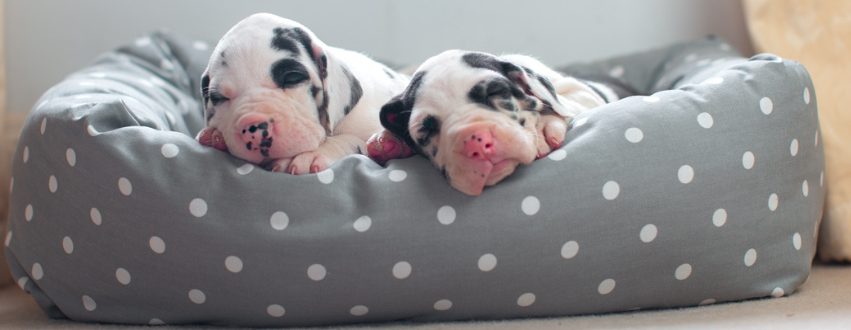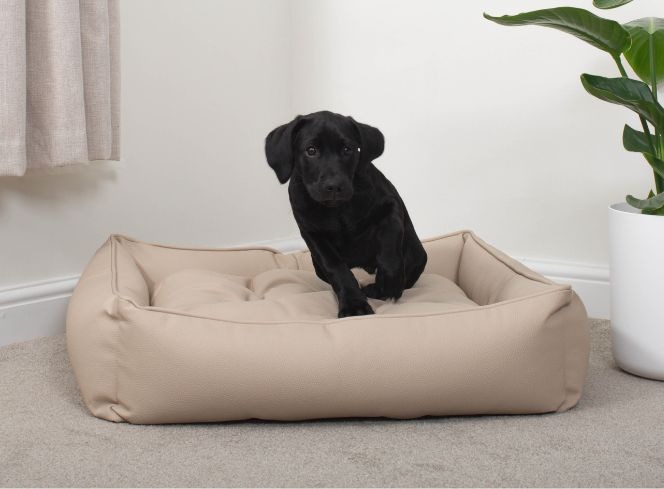If you're a dog owner, you've probably observed your furry friend scratching their bed numerous times before settling down to sleep. This common behaviour might raise questions like "Why do dogs scratch their beds?" or "Why does my dog scratch his bed at night?" In this blog, we'll explore the reasons behind this intriguing habit and shed light on the fascinating world of canine behaviour. So, let's delve into the minds of our beloved four-legged companions and uncover the secrets behind their scratching rituals.
Why do dogs scratch their beds before lying down?
It's not uncommon to witness a dog enthusiastically scratch their bed before finally finding the perfect spot to rest. This seemingly simple behaviour holds deeper roots in their ancestry. Instinctively, dogs have retained the primal habit of creating a comfortable and safe sleeping space by scratching and digging. In the wild, ancestral dogs would dig shallow holes to protect themselves from harsh weather and predators. Today, this behaviour has evolved, but the instinct remains strong.

The connection between scratching and territorial behaviour:
Additionally, scratching their beds may serve as a territorial behaviour for dogs. By pawing at their bedding, they leave behind their scent, which acts as a mark of ownership. In the wild, marking territory was essential for survival, as it deterred rival animals from encroaching on their space. Though domesticated, this territorial instinct remains intact and often manifests in seemingly mundane activities like bed scratching.
Why does my dog scratch their bed at night?
If your dog seems particularly active with bed scratching at night, several reasons could be behind this behaviour. One common explanation is that dogs are crepuscular animals, meaning they are most active during dawn and dusk. As the evening sets in, they may feel an increase in energy and excitement, leading to increased bed scratching before settling down to sleep.

Comfort-seeking behaviour:
Another reason for bedtime scratching is that dogs are naturally inclined to create a cosy and comfortable sleeping spot. By scratching their beds, they might be attempting to adjust the bedding to their liking, ensuring it's just right for a good night's rest.
Preparing the "den" for sleep:
Dogs have an inherent desire for a secure and sheltered sleeping area akin to a den. By scratching at their beds, they might be unconsciously trying to shape and prepare their sleeping spot, mimicking the way their ancestors would prepare their dens in the wild.

What if your dog scratches blankets instead?
Some dogs may not have designated beds but still exhibit scratching behaviour, particularly on blankets or even sofas. This is entirely normal and is likely linked to the same reasons as bed scratching—comfort-seeking, territorial instincts, and the preparation of a suitable sleeping spot.
How To Protect Your Dog’s Bed Against Scratching
While scratching is a natural behaviour for dogs, it can lead to premature wear and tear of their bedding. If you're concerned about protecting your dog's bed and ensuring its longevity, consider implementing the following strategies:
1. Durable and Chew-Resistant Materials:
Invest in a dog bed made from durable and chew-resistant materials. Our Rhino Tough collection is made from high-quality, scratch resistant faux leather with reinforced stitching that’s designed to withstand your dog's scratching and digging tendencies. Avoid beds with easily destructible materials, such as flimsy fabrics or weak seams.
2. Size and Shape Matters:
Choose a bed that is appropriately sized and shaped for your dog. Dogs often scratch their beds to make them comfortable, and a bed that is too small or lacks proper support may prompt excessive scratching. Ensure the bed is large enough for your dog to stretch out comfortably. Not sure on which bed is best for your dog? Check out our 'how to choose a dog bed guide', it contains everything you need to know about helping your canine get the perfect nights sleep.
3. Provide Alternative Outlets:
To redirect your dog's scratching instincts, offer alternative outlets for this behaviour. Consider providing a designated digging area in your garden or a sandpit where your dog can scratch to their heart's content. This will not only protect the bed but also provide a fun and enriching activity for your furry friend.

4. Introduce Bedtime Routines:
Establish a consistent bedtime routine for your dog to help them associate specific behaviours with winding down for sleep. Engage in calming activities such as short walks or playtime before bedtime. When it's time to settle down, gently encourage your dog to lie down on their bed without the need for extensive scratching. Perhaps giving them a calming bedtime biscuit before they go to bed to help with positive reinforcement.
5. Positive Reinforcement:
Use positive reinforcement techniques to reward your dog when they settle down on their bed calmly and without excessive scratching. Offer treats, verbal praise, or tummy rubs when your dog exhibits desirable behaviour. This will reinforce the idea that resting peacefully on their bed is a rewarding experience.
6. Bedding Protection:
Consider using protective covers or blankets over your dog's bed to shield it from scratching. These covers can be easily removed and washed, preserving the integrity of the bed underneath. Look for covers that are easy to clean and maintain.
7. Regular Inspection and Cleaning:
Regularly inspect your dog's bed for signs of wear and tear caused by scratching. Promptly address any loose threads or damaged areas to prevent further damage. Clean the bed regularly to remove dirt, hair, and odours, which may entice your dog to scratch more.
8. Keep Their Claws Short:
Regular nail trimming helps maintain the proper length of your dog's claws, reducing the potential for sharp edges that could snag and tear the bed's fabric. Additionally, shorter nails are less likely to cause discomfort or injury to your dog while they scratch. If you're unsure about how to trim your dog's nails safely why not check out our blog which will guide you through the process?
In conclusion, understanding why dogs scratch their beds provides valuable insights into their instincts and behaviours. While it's challenging to stop this natural behaviour entirely, we can protect their beds by choosing durable materials, offering alternative scratching outlets, and maintaining their nails. Embracing their uniqueness and providing a comfortable space will ensure our furry friends enjoy a peaceful and contented slumber. So, cherish the bond with your canine companion and create a scratch-free haven where they can rest and recharge happily. Sweet dreams to your beloved furry companions!



































































































